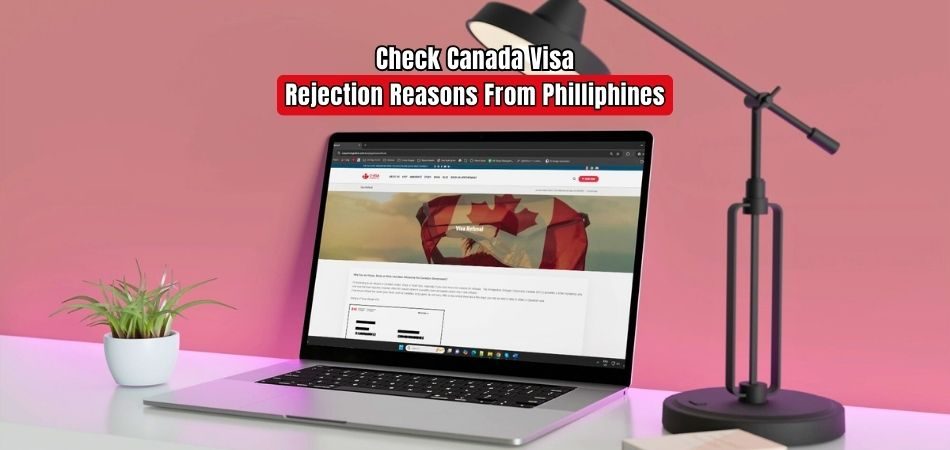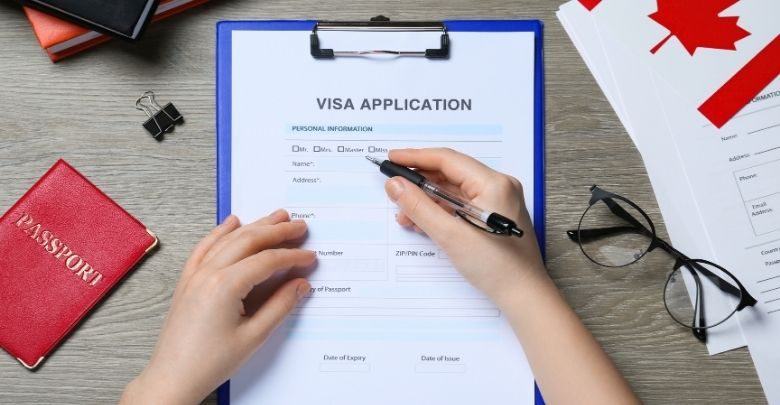Applying for a Canadian visa can be a detailed and complex process that requires precision. If you’ve applied from the Philippines, you might be wondering what steps to take if your visa gets rejected, and this leads to a common question: How to check Canada visa rejection reasons from Philliphines?
To check the reasons for your Canadian visa rejection, review the official communication sent by the embassy. You can also log in to your online immigration account to access detailed rejection notices. For more insights, you can request GCMS notes, which provide a deeper look into the decision process and reasons for refusal.
Do you want to know more about this subject? This article provides all the necessary steps and details you need to know. Keep reading to ensure you have all the right information to address your visa concerns effectively.
What is the Probability of Canadian Visa Rejection for the Philippines?
When applying for a Canadian visa from the Philippines, several factors can influence the likelihood of rejection. The application process is meticulous and requires each applicant to meet specific criteria, including proof of sufficient funds and intent to return home. A common oversight, such as incomplete forms or missing documents, often leads to visa denial.
Additionally, the applicant’s travel history and ties to their home country are crucial. Those lacking a strong travel history or clear economic and social ties to the Philippines might face difficulties. A clean background check is equally important, as any criminal history can negatively impact the visa outcome.
In many cases, applicants encounter issues that lead directly to the denial of their visa application. In that case, knowing the typical reasons for Canada visa rejection can help applicants prepare more carefully and potentially increase their chances of approval. Accurate, complete applications and strong supporting documents are key to addressing the common mistakes in the visa process.
How to Check Canada Visa Rejection Reasons From Philippines?
Managing the process of checking the reasons for a Canada visa rejection can feel overwhelming. However, knowing how to obtain this information is crucial for future applications. Below are several methods to help you check your visa rejection reasons effectively.
Check the Official Communication
After your visa application is processed, the Canadian Embassy will send you an official communication letter. This letter typically contains specific reasons for the rejection. Review this document carefully, as it will provide you with insights into the decision and highlight any missing documents or information.
Online Immigration Account
If you applied for your Canada visa online, your immigration account is a valuable resource. Logging into your account allows you to view the status of your application, including any rejection notice. This online portal provides detailed insights and documentation that can clarify the specific reasons for your visa denial, streamlining your next steps.
Detailed Reasons in the Letter
The rejection letter often contains a list of specific criteria that were not met during the application process. Each reason is typically stated clearly, allowing you to identify areas needing improvement. Being aware of these specific reasons is vital for addressing them effectively in any future applications for a Canadian visa.
Request for GCMS Notes
For a deeper knowledge of the rejection, you can request your Global Case Management System (GCMS) notes. These notes provide a detailed account of how your application was processed and the specific reasons for the rejection. While there is a small fee, this information can be invaluable in strengthening future applications.
Assistance from Visa Application Centers
Visa Application Centers (VACs) offer support for applicants seeking clarity on their visa applications. Visiting or contacting your nearest VAC can help you obtain specific information about your rejection.
Staff members are knowledgeable and can guide you through the process of figuring out your rejection, ensuring you address any issues effectively.
Consultation with IRCC
Contacting Immigration, Refugees, and Citizenship Canada (IRCC) can provide further insight into your visa rejection. You can reach out via phone or email, and they often offer detailed explanations regarding the reasons behind your application denial. Be prepared to share your application details for a more tailored response from their representatives.
Use of Third-Party Services
Some third-party services specialize in assisting applicants with visa inquiries. These services may help you obtain detailed information regarding your rejection. Although they typically charge a fee, they can expedite the process of acquiring relevant documents and insights from the embassy, giving you a clearer understanding of your application.
Embassy Follow-Up
If necessary, consider reaching out directly to the Canadian Embassy in the Philippines. Embassy staff can provide specific guidelines on how to access detailed rejection reasons. This direct communication may clarify any questions you have and offer insights into how to rectify issues for future applications.
Knowing the specific reasons for your Canada visa rejection is crucial. This knowledge will guide you in addressing the issues effectively, improving your chances of a successful application in the future, and ensuring better preparation for your next attempt.
What to Do if Your Canada Visa Rejection Reasons Are Unclear?
When facing unclear reasons for a Canada visa rejection, it can be frustrating and confusing. Below are some important steps to guide you through the process.
Seek Legal Advice
Consulting an immigration lawyer is a smart move if the reasons for rejection seem vague or unclear. Immigration professionals are experienced in dealing with visa denials and can analyze your case closely. They can also help you gather the right information to make sure you don’t face the same issues in future applications.
Review Application Documents
Sometimes, a small mistake or missing document can lead to a rejection. Carefully reviewing the original documents submitted with your application is a critical step. Checking for overlooked issues can help you address the problems and improve your application.
Ask for a Detailed Review
If your rejection notice didn’t provide clear information, you can request a more detailed review from immigration authorities. This request can help clarify the vague areas of your rejection. Often, knowing these specifics can increase the possibility of getting a Canada visa after rejection by avoiding the same mistakes next time.
Consider Reapplying with Updated Information
If your visa application was rejected due to unclear reasons, it might be best to reapply after making significant updates. Ensure all documents are correct, and any issues from the first application are thoroughly addressed. This proactive approach can improve your chances of success.
Stay Informed on Policy Changes
Immigration policies can change, and staying updated on the latest rules is essential. Keeping an eye on updates ensures that your next application meets the current criteria. Being well-prepared can help avoid any further confusion or delays.
Addressing unclear reasons for Canada visa rejection requires careful action and attention to detail. The next time you apply, you can increase your chances of approval by understanding the rejection reasons and making the necessary changes.
How to Correct Mistakes in Your Visa Application?
Fix errors in visa applications as soon as possible because they may cause delays or rejections. Knowing these errors carefully ensures your application is complete and accurate. Below are effective steps to help you correct mistakes in your visa application.
Identify the Mistakes
Begin by reviewing your entire visa application thoroughly. Look for any inaccuracies in your personal information, such as names, addresses, or dates. Take note of any missing documents or incorrect details that could affect your application. Being aware of these mistakes is the first step toward making necessary corrections.
Gather Supporting Documents
Once you identify the mistakes, collect any supporting documents that confirm the correct information. For instance, if your name is misspelled, gather identification that displays the correct spelling. Having these documents ready will help demonstrate the accurate details when you submit corrections to the visa authority.
Contact the Visa Office
Reach out to the visa office or consulate where you submitted your application. Inquire about their specific process for correcting mistakes. Each office may have different procedures, so get clear instructions on how to proceed with your corrections effectively and promptly.
Submit a Correction Request
Prepare a formal correction request letter to explain the mistakes you found. Include all necessary details, such as your application number and specific errors. Make sure to attach any supporting documents that validate your corrections. A clear and concise request will help the authorities understand your situation better.
Follow Up on Your Request
After submitting your correction request, make sure to follow up with the visa office. Check on the status of your request to ensure it is being processed. Staying proactive in your communication can help prevent further delays and demonstrates your commitment to rectifying any issues.
Correcting mistakes in your visa application is essential for a smooth process. Always ensure that you double-check all information and stay informed about the requirements for your specific application to avoid future issues.
Top Tips for Avoiding Canada Visa Rejection in the Future
Preparation and close attention to detail are essential to preventing a visa rejection. With the right approach, you can significantly increase your chances of getting approved. Here are some practical tips to ensure success in your future Canada visa application.
- Provide Complete Financial Evidence: Ensure that your financial statements clearly show your ability to support yourself. Missing or unclear financial proof can easily result in a rejection. Detailed documentation of your funds is essential.
- Ensure Proper Documentation Translation: If your documents are in a language other than English or French, have them translated by a certified translator. Not translated or improperly translated documents can lead to delays or rejections.
- Submit a Strong Letter of Intent: Write a clear and concise letter of intent that explains your purpose for visiting Canada. The letter should detail your plans and convince immigration officers of your genuine intentions.
- Demonstrate Strong Ties to Home Country: Provide proof of your strong ties to your home country, such as employment, property, or family obligations. This demonstrates that you have reasons to return after your visit to Canada.
- Prepare an Accurate Travel History: Include a complete and accurate record of your travel history. Incomplete or inconsistent information regarding previous travels may cause suspicion, leading to your visa application being denied.
- Meet Health and Security Requirements: Ensure that you meet Canada’s health and security standards. Discrepancies in your medical or background checks can result in rejection, so make sure everything is in line with their policies.
- Avoid Last-Minute Applications: Submit your visa application well in advance of your intended travel date. Rushed applications often miss key details, which could easily lead to rejection. Early submission ensures thorough review.
Focusing on these tips will help you avoid common pitfalls in your future Canada visa applications. Proper preparation and attention to detail will make your application process smoother and more likely to succeed.
Frequently Asked Questions (FAQs)
If you were denied a Canada visa, you should know why to increase your chances in the future. Below are some common FAQs that provide clarity on checking Canada visa rejection reasons from the Philippines.
What Happens If I Lose My Rejection Letter?
If you lose your rejection letter, you should immediately contact the Canadian visa office or the immigration portal where you submitted your application. Requesting a duplicate rejection letter is crucial because it contains essential details about the reasons for your denial. This information is vital for addressing the issues in future applications.
Can I Check Rejection Reasons Without An Online Account?
Yes, you can check the reasons for your visa rejection even if you do not have an online account. The Canadian embassy sends an official rejection letter to all applicants. This letter clearly outlines the specific reasons for denial, helping you understand what went wrong with your visa application.
Are There Any Fees To Request GCMS Notes?
Yes, there is usually a small fee associated with requesting your Global Case Management System (GCMS) notes. This fee covers the administrative costs of processing your request. The GCMS notes provide comprehensive details about your application, including insights into the reasons for the rejection, which can help improve future applications.
How Long Does It Take To Receive GCMS Notes?
Typically, it takes about 30 to 40 days to receive your GCMS notes after submitting a request. During this period, immigration authorities process your request and prepare the documents. These notes are crucial for understanding the specific reasons behind your visa rejection and offer detailed insights into your application’s evaluation.
Can A Third-Party Service Help With Rejection Reasons?
Yes, third-party services can assist you in obtaining detailed information about your visa rejection. These services often have experience navigating the immigration system and can provide insights that may not be easily accessible. However, be sure to verify their legitimacy and fees before proceeding with their assistance.
Bottom Lines
It can be difficult to handle the Canadian visa application process, particularly if you are rejected. However, knowing the reasons behind a denial is essential to improving your chances of success for future applications.
To find out how to check Canada visa rejection reasons from Philippines, you should carefully review the official rejection letter sent by the embassy. You can also access your online immigration account for more detailed insights regarding the reasons for the denial, helping you prepare better next time.
As you move forward, remember to double-check all your documents, ensure proper translations, and submit complete financial proof. Stay organized and patient. Best wishes for a smoother visa process and a successful outcome in the future!








